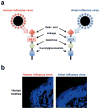The role of receptor binding specificity in interspecies transmission of influenza viruses
- PMID: 22445963
- PMCID: PMC5605752
- DOI: 10.1016/j.coviro.2012.03.003
The role of receptor binding specificity in interspecies transmission of influenza viruses
Abstract
Influenza A virus infection begins with the binding of the hemagglutinin (HA) glycoprotein to sialic acid-containing receptors on the surface of the target cell. Avian influenza viruses, including avian H5N1, H7, and H9N2 viruses, can occasionally cross the species barrier and infect humans; however, these viruses do not spread efficiently from person to person, perhaps, partly, owing to differences in the receptor-binding specificities of human and avian influenza viruses. The HAs of avian influenza viruses must adapt to receptors in humans to acquire efficient human-to-human transmissibility. In this review, we discuss the receptor binding specificity of influenza A viruses and its role in interspecies transmission.
Copyright © 2012. Published by Elsevier B.V.
Figures


References
-
- Laver WG, Webster RG. Ecology of influenza viruses in lower mammals and birds. Br Med Bull. 1979;35:29–33. - PubMed
-
- Palese P, Young JF. Variation of influenza A, B, and C viruses. Science. 1982;215:1468–1474. - PubMed
-
- Skehel JJ, Wiley DC. Receptor binding and membrane fusion in virus entry: the influenza hemagglutinin. Annu Rev Biochem. 2000;69:531–569. - PubMed
Publication types
MeSH terms
Substances
Grants and funding
LinkOut - more resources
Full Text Sources
Medical

